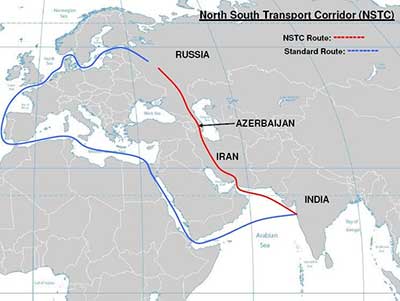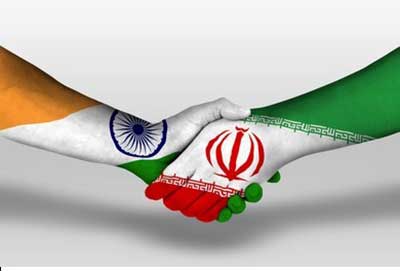Relevance: GS-2: Bilateral, Regional, and Global Groupings and Agreements involving India and/or affecting India’s interests.
Key Phrases: Organisation for Islamic Cooperation, Iranian Foreign Minister visit, Chabahar Port, Iran nuclear deal, International North-South Transport Corridor (INSTC), Iran-Oman-India gas pipeline.
Why in News?
- Iranian Foreign Minister Hossein Amir Abdollahian’s first visit to India has many implications for bilateral relations, but it is the multilateral context and timing that stand out.
Background of Iranian Foreign Minister’s Visit
- Islamic Countries took a strict stance against the offensive comments made in India on the Prophet.
- The Iranian visit comes a week after that of Israeli Defence Minister Benny Gantz.
- Iranian Visit coincides with the meeting of the Board of Governors of the IAEA in Vienna, which has passed strictures against Iran for its nuclear program.
- Ongoing Russia Ukraine War and western sanctions led to an oil export embargo on Russia, providing an opening for Iranian oil to get to International Markets like India.
Significance of the visit:
- For India:
- This visit was an opportunity for New Delhi to project that it has successfully assuaged the Islamic world with the actions of the ruling party against its spokespersons.
- For Iran:
- For Mr. Abollahaian, the visit would be portrayed as a show of support from a powerful country.
- Against the backdrop of the Russian war in Ukraine, and western sanctions, Iran has also been keen to convince New Delhi to restore its crude oil purchases, cancelled in 2019, after threats of U.S. sanctions.
- While there was no public statement on the matter during the official part of the visit, External Affairs Minister called for the U.S. and Europe to allow Iranian and Venezuelan oil back into the international market if they want India to lower Russian oil imports, accusing the West of “squeezing” all alternative sources for India.
Concerns over bilateral front:
- This is the first visit by a member of the 57-member Organisation for Islamic Cooperation, which took offense to comments made in India on the Prophet. The controversy has overshadowed India’s other diplomatic engagements.
- India and Iran have catching up to do, with many promises of the last summit in Delhi left unrealized.
- Instead of increasing Indian oil imports, investments in developing reserves, building up the Chabahar rail project, and scaling up trade, India has drastically cut its Iranian engagement due to sanctions, while Iran has looked to China for more infrastructure investment.
- Bilateral trade dropped to just over $2 billion (2020-21) from $17 billion (2017-18).
- Ties also appeared to have been hit by New Delhi’s surprise decision to join the Israel-India-UAE-U.S. group, portrayed as an “anti-Iran” coalition, and by perceptions of Iranian support to Yemeni Houthis behind the drone attack on a UAE oil facility where an Indian was among those killed.
Chabahar Port
- Chabahar port is located in Iran’s southeastern Sistan and Baluchestan provinces.
- It is located on the Gulf of Oman and is only 72 km away from the Gwadar port in Pakistan which has been developed by China.
- Located on the edge of the Indian Ocean, it is the only deep-sea port in Iran with direct ocean access.
- Its geographic proximity to countries such as Afghanistan, Pakistan, and India, as well as its status as a key transit centre on the burgeoning International North-South Transport Corridor, gives it the potential to develop into one of the most important commercial hubs in the region.
- Chabahar is also one of the few places in Iran that is exempt from U.S. sanctions, which significantly simplifies trade procedures with other countries.

Favourable Conditions for a Reset:
Afghanistan:
- Iran and India discussed the situation in Afghanistan under the Taliban, just days after an Indian envoy made the first outreach to Kabul.
- To this end, India and Iran have discussed further operationalizing the Chabahar port, where goods to Afghanistan were sent before the government in Kabul felt last year.
- Iran and India have collaborated already in the past on Afghanistan and Iran’s role as a viable direct land route to Afghanistan is undisputable.
- India and Iran have the potential to forge a common and effective policy of engagement with Afghanistan in the future.
Iran nuclear deal:
- No nuclear deal means no lifting of economic sanctions on Iran and no crude oil exports from Iran.
- India, which has stressed exercising its strategic autonomy while importing oil from Russia amid sanctions on Russia due to its war with Ukraine, could explore a similar decision point in Iran, opening up a huge potential for trade and cooperation.
International North-South Transport Corridor (INSTC):
- It is an ambitious project launched at the start of this century, though partially operationalized but due to sanctions on Iran, its full potential has not been realized.
- India and Iran could well play a major part in giving INSTC the required boost to reap the benefits of resultant trade.
International North-South Transport Corridor (INSTC):
- It is multi-modal transportation established on 12th September 2000 in St. Petersburg, by Iran, Russia, and India to promote transportation cooperation among the Member States.
- The INSTC was expanded to include eleven new members, namely: the Republic of Azerbaijan, Republic of Armenia, Republic of Kazakhstan, Kyrgyz Republic, Republic of Tajikistan, Republic of Turkey, Republic of Ukraine, Republic of Belarus, Oman, Syria, Bulgaria (Observer).
- It is a 7,200-km-long multi-mode network of ship, rail, and road routes for moving freight between India, Iran, Afghanistan, Azerbaijan, Russia, Central Asia, and Europe.
- It links the Indian Ocean to the Caspian Sea via the Persian Gulf onwards into Russia and Northern Europe.

Iran-Oman-India gas pipeline:
- The Iran-Oman-India gas pipeline is an ambitious project that has been stuck for a long time.
- Fortunately, Iran, and Oman signed a deal to develop two gas pipelines and an oil field along their maritime borders. If this comes through, there is potential for the pipeline to be extended to India, which would help overcome the loss of the failed Iran-Pakistan-India (IPI) pipeline and facilitate the supply of natural gas to India.
Rebalancing of the West Asian region:
- The reluctance of the United States to remain actively engaged in the Middle East has also made the nations in the region think about alternatives.
- Things are changing in the region rapidly. Growing positive relations among the west Asian nations gives India the tremendous opportunity to develop and scale up its cooperation with Iran without fear of losing out on other friends in the region.
- At some point in time, India may emerge as the perfect interlocutor in the region, as it has the trust and confidence of all stakeholders.
Conclusion:
- Mr. Abdullohaian’s visit, and a possible visit by Iranian President Ebrahim Raisi, may be the start of a reset of traditionally strong ties even if it is buffeted by developments in other parts of the world.
- India and Iran have a lot that can be achieved together. The assertive diplomacy being practiced by India, emphasizing on standing by its neighbours and friends and focusing solely on fulfilling its national interests, is a refreshing change.
- If India can extend the same vision toward its engagement with Iran, it could open a huge potential for cooperation between these two great nations and civilizations.
Source: The Hindu
Mains Question:
Q. How can India and Iran rebuild their ties affected adversely by recent global events?







